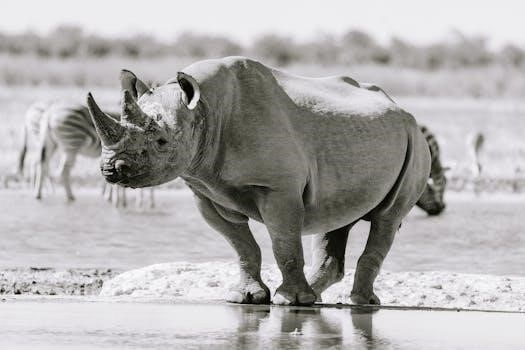The black rhinoceros‚ Diceros bicornis‚ is one of two African rhino species. These critically endangered mammals are known for their hooked lip and unpredictable nature. They have suffered a drastic population decline due to poaching and habitat loss.
Overview of the Black Rhino Species
The black rhino‚ often referred to as the “hook-lipped” rhino‚ is a critically endangered species native to Africa. It is the smaller of the two African rhino species and is known for its unique physical characteristics and browsing habits. Black rhinos are solitary animals‚ and their behavior can be unpredictable. They are an important part of their ecosystem‚ acting as an umbrella species‚ meaning their conservation aids other species. The black rhino has faced significant population declines due to poaching for their horns and habitat loss. There are currently around 5‚550 black rhinos in the wild. Their conservation is a major concern‚ with ongoing efforts to protect them.

Physical Characteristics
Black rhinos are characterized by two horns‚ a pointed upper lip‚ and a robust build. They typically weigh between 700 and 1‚350 kg and stand about 1.5 meters tall.
Size and Weight of Black Rhinos
Black rhinos are substantial animals‚ with adults typically weighing between 700 and 1‚350 kilograms‚ which is about 1‚500 to 2‚900 pounds. Males and females tend to be roughly the same size‚ standing approximately 1.5 meters‚ or 5 feet‚ tall at the shoulder. Their body length can reach up to 3.5 meters‚ or 11.5 feet. These impressive dimensions make them the third-largest rhinoceros species. Their weight can be more than 20 times the average weight of a human. These measurements emphasize their powerful stature‚ which is important to consider in their ecological role.
Distinguishing Features⁚ Lip Shape and Horns
A key distinguishing feature of the black rhino is its pointed‚ hooked upper lip‚ which is adapted for browsing on trees and bushes. This differs significantly from the white rhino‚ which has a squared lip. Both black and white rhinos possess two horns‚ though their size and shape can vary. The horns are made of keratin‚ the same material as human fingernails‚ and are a primary target for poachers. The black rhino’s unique lip structure reflects its diet and browsing habits‚ a critical difference from other rhino species.

Habitat and Diet
Black rhinos are browsers‚ thriving on trees and bushes. Their habitat includes a variety of landscapes. They adapt their diet based on available plant species‚ demonstrating diverse feeding habits.
Black Rhino’s Preferred Habitats
Black rhinos demonstrate a notable adaptability in their choice of habitats‚ though they generally prefer areas that offer sufficient vegetation for browsing. These habitats often include dense thickets‚ woodlands‚ and scrublands‚ which provide both food and cover from predators and the elements. They can also be found in open savannas with scattered trees and bushes‚ taking advantage of the varied plant life. Black rhinos also tend to favor areas with access to water sources‚ which are essential for their survival‚ especially in drier climates. Their choice of habitat is also influenced by the availability of specific plant species that form a significant part of their diet. The presence of suitable browsing material plays a crucial role in determining their distribution within a particular region‚ making habitat protection vital for their conservation.
Dietary Habits⁚ Browsing Behavior
Black rhinos are primarily browsers‚ which means their diet consists largely of leaves‚ shoots‚ and branches from trees and bushes. Their unique‚ hooked upper lip is perfectly adapted for grasping and stripping foliage from plants. They are not grazers like their white rhino counterparts‚ which feed on grasses. Instead‚ they use their prehensile lip to selectively pick out specific plant parts. The black rhino’s varied diet includes a wide range of plant species‚ including acacia‚ euphorbia‚ and other thorny vegetation. Their browsing behavior is essential for maintaining the health of the ecosystems they inhabit as they help to regulate the density of vegetation. Their diet often depends on the availability of plant species in their specific habitat.

Conservation Status and Threats
The black rhino is listed as Critically Endangered by the IUCN. Major threats include poaching for their horns and habitat loss due to human encroachment. These factors have severely reduced their numbers.
IUCN Red List Status⁚ Critically Endangered
The black rhino’s classification as “Critically Endangered” on the IUCN Red List highlights the severe risk of extinction that this species faces. This status was assigned due to a significant population decline‚ with numbers plummeting by 96% between 1970 and 1993. The situation worsened‚ leading to the official “Critically Endangered” status in 1996. This designation signifies the urgent need for continued and intensified conservation efforts. The international trade in rhino horn and habitat loss are the primary drivers behind this classification. The ongoing poaching and human intrusion into their habitats have pushed the black rhino population to the brink‚ making their conservation a global priority. The future of these animals depends on successful strategies.
Major Threats⁚ Poaching and Habitat Loss
The primary threats to black rhinos are poaching and habitat loss. Poaching is driven by the high demand for rhino horns‚ which are used in traditional medicine and as status symbols. This illegal trade has decimated rhino populations. Habitat loss‚ caused by human encroachment‚ agriculture‚ and infrastructure development‚ further constrains their survival. As human populations expand‚ rhino habitats shrink‚ fragmenting populations and limiting their access to resources. This combined impact of poaching and habitat loss has resulted in a catastrophic population decline‚ pushing the black rhino to the brink of extinction. Addressing these threats requires international cooperation and continued conservation efforts.
Population and Distribution
Currently‚ there are approximately 5‚550 black rhinos across Africa. Their numbers have drastically declined from an estimated 65‚000 in 1970 due to poaching and habitat pressures.
Current Black Rhino Population Numbers
The black rhino population currently stands at around 5‚550 individuals across Africa. This number reflects a significant decline from historical figures‚ highlighting the severe impact of poaching and habitat loss. Conservation efforts are underway to bolster these numbers‚ but the species remains critically endangered. While some populations are showing signs of recovery‚ the overall situation is precarious. These efforts include anti-poaching measures‚ habitat protection‚ and range expansion initiatives aimed at securing a sustainable future for this iconic species. The current population size underscores the urgent need for continued and intensified conservation action.
Historical Population Decline
The black rhino has experienced a devastating population decline over the past century. In 1970‚ it’s estimated there were around 65‚000 black rhinos in the wild. However‚ due to rampant poaching and habitat destruction‚ their numbers plummeted by a staggering 96% between 1970 and 1993. This drastic reduction led to the species being classified as Critically Endangered by 1996. The early 20th century saw over 500‚000 rhinos in Africa and Asia combined‚ highlighting the scale of the loss. The historical decline underscores the urgent need for conservation efforts to prevent further population reduction.

Conservation Efforts
Conservation of black rhinos includes anti-poaching measures‚ habitat protection‚ and range expansion. These efforts are crucial to bolstering their numbers and improving their conservation status.
Anti-Poaching Measures
Combating poaching is a critical aspect of black rhino conservation‚ as the illegal trade in rhino horn is the main cause of their decline. Anti-poaching efforts include increased ranger patrols and surveillance in protected areas‚ use of advanced technologies like drones and tracking devices‚ and engagement with local communities to combat poaching. Moreover‚ international cooperation is needed to disrupt trafficking networks. These measures are vital to protect rhinos from poachers and ensure the survival of the species. Such efforts are often conducted by organizations like the IRF and WWF‚ focusing on areas where the rhinos are most threatened.
Habitat Protection and Range Expansion
Protecting and expanding black rhino habitats is essential for their long-term survival. This involves establishing and maintaining protected areas‚ such as national parks‚ and working with private landowners and communities to secure suitable habitats. Furthermore‚ habitat management techniques are used to ensure rhinos have access to food and water sources. Range expansion efforts include relocating rhinos to new areas to establish additional populations‚ which is important for genetic diversity. These measures are crucial for mitigating habitat loss and fragmentation‚ some of the major threats faced by black rhinos. Conservation efforts must focus on these key aspects.
Subspecies of Black Rhinos
Several subspecies of black rhinos once existed‚ with the Southern black rhinoceros being the largest. Sadly‚ this subspecies‚ once abundant‚ is now extinct due to excessive hunting and habitat destruction.
The Extinct Southern Black Rhinoceros
The Southern black rhinoceros‚ also known as the Cape black rhinoceros (Diceros bicornis bicornis)‚ represents a tragic loss in the history of black rhino conservation. This subspecies was once widespread‚ thriving from the Cape of Good Hope to Transvaal‚ South Africa‚ and likely extending into southern Namibia. It was distinguished as the largest of all the black rhino subspecies. Unfortunately‚ due to relentless hunting pressures and widespread habitat destruction‚ the Southern black rhinoceros was driven to extinction. Its disappearance serves as a stark reminder of the devastating impact of human activities on wildlife populations. The loss of this subspecies underscores the urgency of current conservation efforts aimed at protecting the remaining black rhino populations.
The Role of Black Rhinos in the Ecosystem
Black rhinos are considered an umbrella species‚ meaning their conservation protects many other species. Their presence maintains a healthy ecosystem‚ benefiting a variety of flora and fauna within their habitat.
Black Rhinos as Umbrella Species
Black rhinos play a crucial role in their ecosystems‚ acting as an umbrella species. This means that by focusing conservation efforts on black rhinos‚ a wide range of other species that share their habitat are also indirectly protected. The conservation and monitoring of umbrella species like the black rhino is essential‚ as their well-being ensures a healthier and more biodiverse environment for all the plants and animals that rely on the same resources. Therefore‚ protecting these rhinos has a cascading positive effect across the entire ecosystem‚ maintaining its balance and promoting biodiversity. Black rhinos are vital for the overall health of their habitats.
